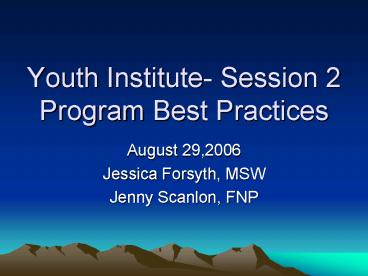Youth Institute Session 2 Program Best Practices - PowerPoint PPT Presentation
1 / 13
Title:
Youth Institute Session 2 Program Best Practices
Description:
Youth-serving does not always equal youth-friendly and culturally competent. ... How do we ensure that youth-friendly services are in places? ... – PowerPoint PPT presentation
Number of Views:59
Avg rating:3.0/5.0
Title: Youth Institute Session 2 Program Best Practices
1
Youth Institute- Session 2 Program Best Practices
- August 29,2006
- Jessica Forsyth, MSW
- Jenny Scanlon, FNP
2
Goals of Presentation
- Identify the best practices of the Childrens
Hospital Immunodeficiency Program (CHIP) of
Denver for - Identifying, engaging and retaining youth
- Designing youth-centered services
- Opportunities and challenges in peer work
- Effective community collaborations in meeting the
diverse needs of youth
3
CHIP an overview
- CHIP is a Title IV program serving children,
youth, women and families. Began as Pediatric
AIDS Clinical Trials Group site. - The CHIP Youth Project (CYP) includes a
multidisciplinary team (social work, nursing,
physicians, nutritionist, pharmacist, mental
health) that serves 65 youth living with HIV and
their affected support network.
4
CHIP Youth Project Continuum of Care
- Care services youth-specific, youth friendly
clinic, social work/case management, GLBT
culturally proficient providers, support groups,
mental health treatment. - Counseling and Testing OraSure and rapid tests
in xxx sites xxx youth tested. - CYP becoming well-known as point of entry for
youth living with HIV.
5
What does it mean to engage?
- Must have the core belief that youth can, and
will, make good decisions about their health if
given accurate information and consistent
support. - Must know how to enter into a therapeutic
alliance with youth building on their strengths
to develop their capacity to advocate for
themselves
6
Challenges of Engagement
- Developmental present-time orientation,
reliance on peers, unstructured lives,
establishment of independence and feelings of
immortality. - Mental health - Seventy percent of CYPs clients
have a mental health diagnosis 43 have
substance abuse issues. - Pediatric infrastructure not prepared to handle
complex social issues of youth living with HIV
7
CYP Engagement and Retention
- One consistent point of entry helps to streamline
process (social work) - Basic support services help keep youth engaged
initially food vouchers for clinic,
transportation, etc. - Real engagement is due to the exceptional
staffing staff are culturally proficient and
dedicated to youth. Have flexible schedules,
clinic times and low case loads. - Strong team collaboration Nurse Practitioner
and social worker see clients together, work
seamlessly to meet the needs of youth.
8
CYP Retention
- Effective engagement often leads to retention but
when it doesnt.. - Case finding critical to retention. Entire CYP
team participates (social worker, nurse
practitioner, outreach coordinator, etc). From
youth entered into the program since 8/04, CYP
has a 93 retention rate. - Peers as team members are critical to having
success in recruiting, engaging and retaining
youth in care.
9
Peers Invaluable Team Members
- Peer demographics have run the gamut living
with HIV, affected, ages have varied, but most
share life experiences with youth living with
HIV. - Excellent representatives of youth programs and
effective relationship builders. Can reach youth
in a way adult professional staff often cant. - CANNOT be tokens must be involved in the
design, implementation and evaluation. Effective
youth-adult partnerships see Advocates for
Youth materials
10
Challenges in Peer Work
- Often have high supervisory and mentoring needs.
Critical for programs to allow for that and not
underestimate issues that arise for young people
in doing their work. - Aging up what happens as they get older/need
more challenging work? - Hiring youth who receive care from your program
do they switch their care? How does the team
manage boundary issues?
11
Community Collaborations
- Testing sites
- Youth serving agencies Mental Health, shelters,
GLBT youth drop-in centers. Staff must know that
the referrals they make are to youth-friendly
places. Youth-serving does not always equal
youth-friendly and culturally competent. - State health department Prevention Case
Management, prevention with positives, CDC
prevention initiatives (DEBI) - Cross-Title Collaborations how are the Titles
(I, II and III) addressing the needs of youth
(WICY)? How do we ensure that youth-friendly
services are in places? How do we convince
people that youth are 13 to 24?
12
CYP Challenges in Youth Work
- Staff does not reflect clients racial and
ethnic- a particular challenge in Colorado - Challenges of developing youth-sensitive systems
of care within a pediatric-focused facility. How
do childrens hospitals address the changing
epidemic? - Mental health (psychiatry) and substance
abusefunding and community capacity to serve is
lacking for youth. - Transition of youth to adult care how do get
the adult care providers to engage?
13
Contact Information
- Jessica Forsyth, MSW
- Youth Program Director
- Children's Hospital - CHIP
- forsyth.jessica_at_tchden.org
- 303-861-6758































